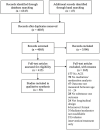Targets for intervention to prevent substance use in young people exposed to childhood adversity: A systematic review
- PMID: 34097711
- PMCID: PMC8183991
- DOI: 10.1371/journal.pone.0252815
Targets for intervention to prevent substance use in young people exposed to childhood adversity: A systematic review
Abstract
Background and aims: Childhood adversity is a strong, and concerningly prevalent, risk factor for the later development of substance misuse. Yet despite substantial accumulating evidence for causal mechanisms, there has been little attempt to synthesize the strength of the evidence. Importantly, these mechanisms may be amenable to intervention, providing targets for substance use prevention among those exposed to childhood adversity. The present review aimed to systematically identify mediating and moderating mechanisms operating between childhood adversity and substance use.
Methods: A systematic review was conducted. Electronic databases (PubMed, MEDLINE, PsycINFO, Web of Science and CINAHL) were searched from 1998 to 2020 for modifiable mediators and moderators of the relationship between childhood adversity and substance use in people aged 10-24. Data was qualitatively synthesised, using a socio-ecological perspective to group mediators/moderators into individual, interpersonal, community, and public policy/cultural levels of behaviour.
Results: After screening against eligibility criteria, 50 studies were included in the current review. The mediators at the individual level of behaviour showing the largest and most consistent effect sizes included externalising behaviour, anger, coping motives for substance use, and post-traumatic stress symptoms. Among individual-level moderators, religiosity, future orientation and depressive symptoms all attenuated the relationship between childhood adversity and substance use. At the interpersonal level, peer relationships and mother-child relationships mediated the effect of adversity on substance use. Moderators included family cohesion and relationship quality. Community factors were less commonly studied, though school mobility and educational achievement mediated 14% and 28% of the total effect of childhood adversity on substance use respectively. No mediators or moderators were identified for public policy/culture.
Conclusions: A substantial proportion of the relationship between childhood adversity and substance use in youth is mediated through individual, interpersonal and community factors. Coupled with the knowledge that existing, evidence-based programs effectively address many of the identified mediators and moderators, this review advances knowledge on optimal targets to prevent substance misuse among those exposed to childhood adversity.
Conflict of interest statement
The authors have declared that no competing interests exist.
Figures



References
-
- Bellis MA, Hughes K, Ford K, Ramos Rodriguez G, Sethi D, Passmore J. Life course health consequences and associated annual costs of adverse childhood experiences across Europe and North America: a systematic review and meta-analysis. Lancet Public Health. 2019;4(10):e517–e28. doi: 10.1016/S2468-2667(19)30145-8 - DOI - PMC - PubMed

